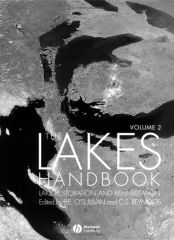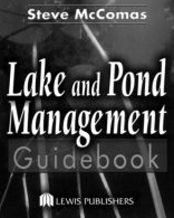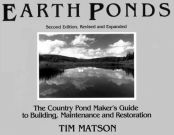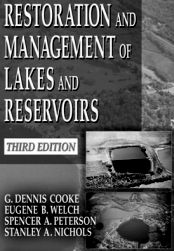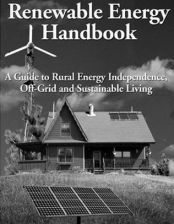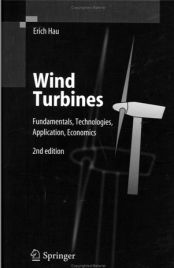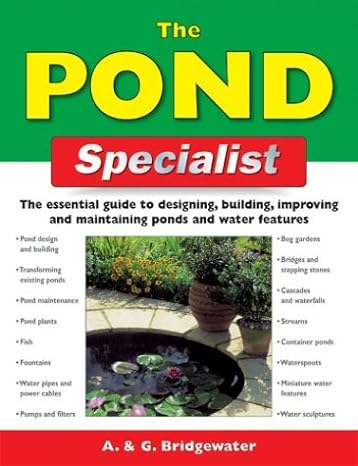Dock
Bubbler Packages
What
you need for a bubbler de-icer for a dock, boathouse or marina. A
step by step guide for setting up your dock bubbler
**
Bubblers are for dock areas less than 6 feet deep usually and deicers
and thrusting agitators are for dock and marina areas that have more
than 6 feet of depth.
The principle
of a keeping a dock or marina clear of ice is to ensure that the natural
crushing pressure of ice is not able to squeeze the structure. Ice
is so powerful that it can literally lift lake bed pilings out of
their footings and toss them about like sticks. I have seen large
yachts tied up in large Eastern Seaboard marinas suffer thousands
of dollars of damage due to ice.
The sad
part is that almost all cases of ice damage and dock damage are a
result of negligence by the owner or sheer laziness; installing a
homemade dock deicer or dock bubbler is not really difficult but the
key is to start preparing components and supplies early enough in
the season, October or November, to not get caught without a viable
system when the cold snap first falls and often surprises!
While ice usually forms in shallow or areas in lakes and ponds without
circulation it is important to remember that early ice formations
can occur in November in some areas.
Dock
Bubblers & Packages
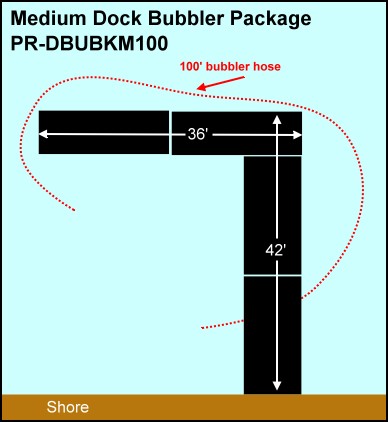
More
info
Diffused
Air Dock Bubblers
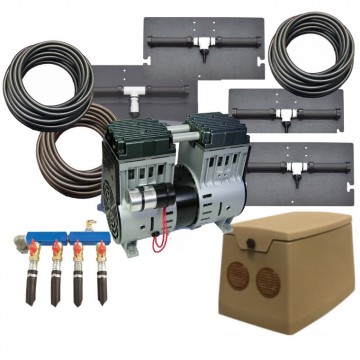
More Info
Industrial & Commercial Deicing
 Our
deicing experts have years of experience with design and installation
of bubblers and de-icers in mining, stormwater, gas and oilsands
and tailings ponds, ski hills, municipal docks and marinas
and dam deicing and pumphouse deicing. Using the most efficient
systems we can design or recommend the ideal deicing or bubbler
system for any job, large or small. Our
deicing experts have years of experience with design and installation
of bubblers and de-icers in mining, stormwater, gas and oilsands
and tailings ponds, ski hills, municipal docks and marinas
and dam deicing and pumphouse deicing. Using the most efficient
systems we can design or recommend the ideal deicing or bubbler
system for any job, large or small.
Please contact
us by email for industrial deicing jobs.
|
While typical ice
thickness will not maintain a constant spread until December in most
Northern Latitudes the freezing of ponds can occur without warning
so it is better to buy an inexpensive dock bubbler or build a dock
deicer before it is in January and the ice is thicker than you'd like!
Step
1: Install the compressor in your boathous or shed. Build
a simple wooden box if you don't have a nearby shelter handy.
Step 2: Connect the weighted airline
to the valve outlet that is supplied with the compressor. Tighten
clamps firmly but do not overtighten.
Step 3: Connect the weighted self-sinking
airline to the bubbler tubing. Do not bend it sharply as it can kink.
The lead keel can be cut with metal shears. Make sure the end of the
bubbler tubing has a plug on the end!
Step 4 : Start the compressor. Having
airflow running through the line during submersion helps ensure your
placement is correct as you can follow the bubbles at the surface
and ensure the water movement is uniform.
Step 5: Install the diffuser de-icer
line around the area you want to keep free from ice. Usually the tubing,
which is weighted, is placed on the outside edge of the structure
you are trying to protect. The tubing should be kept on a fairly consistant
depth or you will lose bubbles in deeper zones. The tubing can also
be attached to the pilings of the dock or fixed to suspended stakes
which are attached to the dock to ensure the tubing is at a consistant
depth.
Step 6: You're done..there is no Step
6!
Types
of deicers, ice eaters and dock bubblers
We usually help three different kind of people with building their
bubbler;
1 - People with a small boat slip or
boathouse they want to keep ice free so they can leave everything
in place and not hail their boat out every winter,
2 - People who have larger docks our
breakwaters out into a bay, lake or pond, either freshwater or saltwater,
who need to keep large areas free of ice.
3 - Marina owners who need to keep
multiple slips and dock pilings free from the pressure crush of
pack ice or moving pack ice which can damage a dock or valuable
boats.
Ice
Eater® Dock Bubbler Deicers
 Price
Includes USA Shipping Price
Includes USA Shipping
The
most energy efficient dock deicer is the Ice Eater®
which uses a patented design and PVC flow director that
circulates water to the surface, causing turbulence that
reduces or eliminates ice formation around docks.
More
info
1
HP - 25' cord
Ice Eater® P1000 1 HP with 25
foot cord
Up to 80' diameter of open water
7.0 Amps - 115 volts
More
Info and price |
To
see more Ice Eater® cord lengths and 230V options
click
here.
Kasco Agitator Thrust Deicers
 Best
prices on Amazon Best
prices on Amazon
Mounted in either a vertical or
horizontal position, the de-icer circulates water to the
surface, causing turbulence that reduces or eliminates
ice formation.
Affiliate link: More
info on Amazon Kasco store |
1
HP 4400D - 25' cord
Kasco
1 HP with 25 foot cord
More
info |
Bubbler
Hose
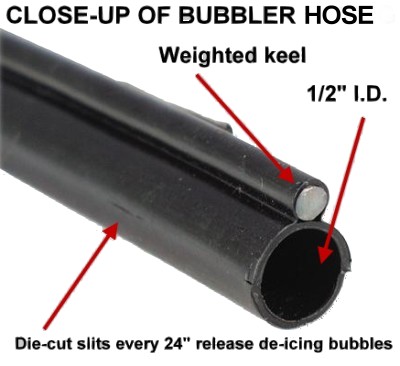 Weighted
de-icer airhose/bubbler tube for deicing small and large
areas. Weighted 1/2" I.D. tubing requires only 1 CFM per
100 feet (0.01 CFM per foot). Single runs of up to 200'
can be used with even bubble flow. Flexible tubing has
a lead-wire encapsulated in poly to act as a weighted
keel, keeping the deicer tubing firmly on the bottom.
Weighted
de-icer airhose/bubbler tube for deicing small and large
areas. Weighted 1/2" I.D. tubing requires only 1 CFM per
100 feet (0.01 CFM per foot). Single runs of up to 200'
can be used with even bubble flow. Flexible tubing has
a lead-wire encapsulated in poly to act as a weighted
keel, keeping the deicer tubing firmly on the bottom.
More
info. |
125'
Bubbler De-Icer Hose
One-hundred twenty-five feet of weighted
deicer bubbler tubing
Price
and options |
Dock
Bubbler Packages
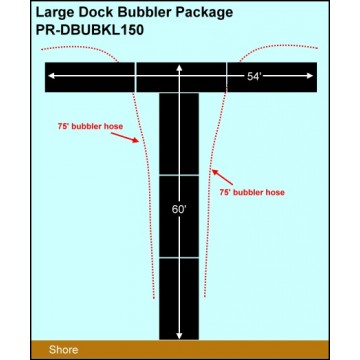 Price
Includes USA Shipping Price
Includes USA Shipping
Some systems use self-weighted
synergistic diffuser assemblies have some of the smallest
and finest bubbles available in any diffuser and this
means that you get the most lifting of water column towards
the surface and less pressure loss during operation. Using
the proper diffuser or perforated hose for bubbling makes
all the difference in protecting a boat or a seawall.
. More
info |

Secure Shopping with Credit Card or Paypal®
More
products available at the Pond
Report Store
|
|
For the small
and medium sized applications we have built two all inclusive packages
that include all the componants you need including compressor, tubing,
bubbler line, clamps, connectors, caps and hardware. The small system
includes 100 feet of self-sinking bubbler hose and 100 feet of weighted
airline while the larger system has 250' of bubbler hose and 100
feet of self-sinking airhose.
Rotary Vane Compressor with high efficiency and energy saving build
means electrical costs are at a minimum. The compressors are efficient
rotary vane compressors which provide good airflow and pressure.
The larger systems are rated at 9.5 CFM at 5 PSI and 8.8 CFM at
10 PSI and are available in single and triple phase configuration.
When you buy our smaller packages the pump is a 1/4 HP rotary vane
pump that delivers 4.0 CFM at 5 PSI and only uses 5 AMPS. The compressors
are not designed to be left outside in the snow and rain so a small
shelter must be built to house the compressor, or you can use a
boathouse or existing fockside shed to put your compressor.
Diffuser Tubing also called diffuser line, de-icing hose or bubbler
line or De-Icer Tubing can be useful in bubbler systems and dock
and boathouse bubblers when the traditional de-icers do not work
due to the shallow natuer of the dock. While some people we know
have had success building a bubbler line out of scehedule 40 PVC
pipe with small 1/16" holes drilled every 12 inches or so this
can require very large pumps and often the lines fill with water
or perform only partly due to slight differences in hole size.
The tubing in this de-dock bubbler package has unique die cut slits
located every 1-1/2" in groups of three which flex the airline
tubing and allow air bubbles to flow and rise to the surface performing
the deicing. The tubing slits close when air pressure is stopped
and any water that accumulates in the bubbler tubing will be blown
out of the holes upon the re-starting the compressor.
This sort of deicer
works best when you have deeper waters around the dock but keep in
mind that even an agitator aimed at the shallow shoreline, if it originates
in waters of say 12 feet deep, can create a large opening under the
entire dock structure. The size of the opening in the ice depends
on the overall ambient air temperature but typically even a 1/2 HP
or 3/4 HP device can open up a hole in the ice up to 60 feet in diameter.
When it is desirable
to prevent ice damage in large marinas or yacht clubs over winter
several units can be combined together to create a huge current that
will open upon incredibly large amount of water. These units can either
be suspended below the dock or pilings by nylon mooring ropes or can
be attached to some sort of dock mount system. Several manufacturers,
like Kasco Marine, offer high quality dock mount apparatus that allow
you to strictly control the angel of attack of the deicer unit by
using a graduated bracketing system.
When a dock
is in shallow waters the popular deicer or ice eater may not work
as well because this sort of motor needs to push warmer waters to
the surface in order to be effective. When waters are 6 feet deep
or less there is less temperature stratification in the water and
even the water at the very bottom can be too cold to effectively melt
surface ice.
While the agitation of the water will keep a small hole open even
when trying to deice a shallow area the diameter of the hole is typically
smaller.
In shallow waters the most popular system is called a bubbler or a
dock bubbler. This sort of system involves an air compressor on the
dock or shore mounted that blows air into diffusers or a diffuser
line like a diffuser line, de-icing hose or bubbler line or deicer
tubing which is a weighted perforated tubing that releases tiny bubbles
down the length of the tubing.
The long linear length of bubbles creates a constant movement of water
and this steady flowing curtain of bubbles ensures that there is no
ice formation along the dock structure or boat slips.
Previous generations
of weighted tubing were lead-lined stiff plastic PVC tubing with die
cut slits ever 12 to 18 inches. I have found this tubing to be susceptible
to kinks and ruptures not to mention the lead metal keel that was
designed to keep the tubing on the pond bottom actually used a poisonous
metal which has since fallen out of favor with anyone concerned about
the potential health effects of heavy metals in our water. Newer developments
in diffuser tubing have seen improvements in efficiency and safety
by using all PVC diffuser tubing that contains zero metals.
PVC is a polymer of vinyl chloride and is insoluble in most organic
solvents. Such diffuser line, de-icing hose or bubbler line, being
constructed of vinyl resins, which are used in soft flexible films
for food packaging and in molded rigid products, such as pipes, fibers,
upholstery, and bristles, is a more environmental choice. Plus, the
ability of such new diffuser tubing to remain flexible in cold temperatures
makes it's use as a deicer tubing much more practical.
While the installation of such a dock bubbler system can be more labor
intensive than the relative ease of installing a dock deicer, there
are advantages.
A dock bubbler,
because it uses an air compressor or regenerative blower, will cost
less in electrical consumption compared to an ice eater agitator.
Submersible motors run from 3 amperes to over 20 amperes depending
on the horse power of the motor. An air compressor for a dock bubbler
will run between 2 and 10 amperes.
When using
diffuser lines to protect your dock from ice damage there will be
some fairly common installation procedures: place the air compressor
in a ventilated cabinet or shed. Some turnkey deicer systems come
standard with a lockable cabinet designed to resist salt water and
rust but some cheap deicers or homemade deicers do not include or
even mention the need for a protective housing for the compressor.
In our northern climates where winter temperatures near the Great
Lakes can be a bone chilling minus 30 degrees for weeks on end it
is essential to protect the compressor.
I have seen some inexpensive dock Bubblers that appeal to the do it
yourself deicer types that claim that the compressor can sit on the
dock without worry but that is a recipe for disaster! The compressor
could be damaged by severe weather or in the case of a power failure
could be destroyed by the freezing of any condensation in the compressor
housing so don't be fooled into thinking a small dock can use a small
linear air pump that sits on the end of the dock.
From the blower or air pump a weighted line runs into the water. The
line can be buried but if you are using a thick walled and high bore
airline you can often get away with surface layout. At the end of
your airline you attach the diffuser line, de-icing hose or bubbler
line or diffuser line which typically runs the length of the dock
in need of protection. I sometimes recommend running multiple lines
of tubing or a perimeter loop depending on the layout of the boathouse
and boat slips involved.
Remember that variations in depth can affect the bubble flow of the
diffuser tubing so it is better to use multiple lines if there are
major deviations in depth around the marine or private dock. Sometimes
even a variation of a few feet can inhibit the correct flow of air
in a tubing. Since one PSI is equivalent to 2.3 feet of depth a difference
of few feet could mean that air flow in the weighted tubing is restricted
in the deeper areas and no bubbles are being released.
I have seen dock bubbler systems that include single lengths of tubing
meant to be placed in a loop of over 400 feet and I have often seen
large areas with no bubbles in such installations especially when
undersized linear compressors are used. The temptation to buy a cheap
bubbler are everywhere on the Internet but it is important to understand
the limitations of the technology before leaning towards buying the
cheapest system.
Of course, in larger marina projects, where hundreds of boat slips
are involved and the dock structure is hundreds of feet of complex
maze-like boat stalls a larger, more professional grade system is
required. In projects like these we will install large high pressure,
high CFM compressors to feed multiple lengths of 1/2 inch or 3/4 inch
diffuser tubing. 3 HP to 5 HP compressor are not uncommon using a
series of control manifold valves to control the airflow into multiple
lines of diffuser bubbler hose.
Regardless of the system you choose it is wise to control the operation
of the dock deicer or dock bubbler with a thermostat control that
will only initiate operation of the motor when freezing temperatures
warrant operation: usually when the air temperature is gist below
the freezing threshold.
These inexpensive thermostats measure the outside air temperature
and engage the air compressor or submersed thruster only when it is
required. Another benefit of using a thermo control unit are the savings
in electricity costs associated with the deicer.
Building
your own deicer, do it yourself dock Bubblers
Send us
an email describing your
dock, marina or boathouse and our design team will submit an affordable
bubbler plan or deicing strategy or
take a look at our dock
bubbler packages
Saving
money is something most of us want to do and when confronted with
the cost of a commercial de-icer I often hear people ask how they
can build a cheap deicer or as me how to build a dock bubbler. It
can be done but before you consider taking on the task ask yourself
if it is really worth the time and effort to buy the parts required
and, of course, the actual labor it entails to build a pond bubbler.
If your
goal is to protect your dock and eliminate costly repairs from winter
ice damage then you should weigh the cost benefits of purchasing a
pre-designed system from a local expert. If you are gung-ho about
doing it yourself it is really not rocket science! Building a dock
bubbler involves buying a cheap pump, adding some airline, and then
adding a diffuser hose or even diffuser discs at strategic points
under the dock or boat slips. I've seen small deicers built for less
than $600 dollars but I've also seen such systems fail due to poor
design and costly boat and major dock repairs resulting!
Using standard PVC plumbing pipes and drilling holes with a hand drill
is one way to avoid buying professional grade diffuser tubing but
one errant drilling of a hole can result in catastrophic failure of
the system. Pumping air through an open ended pipe, creating large
coarse bubbles, will work to an extent but often the results are hit
and miss.
Today's systems have undergone years of testing and while the temptation
is often there to build a homemade bubbler is often nagging at our
thrifty instinct I have seen such desires lead to more expenses that
would have been involved in buying a dock bubbler from a reputable
and experienced supply store.
Buying a dock bubbler or a de-icer
Buying
a dock bubbler or a de-icer requires a certain level of expert knowledge.
The Internet is full of websites that sell dock Bubblers and promote
their simple systems and most claim that they do the job without
issue. I have seen disappointment in many purchases because the
retailer was more keen on selling their product than actually customizing
a bubbler system to meet the specific needs of the clients particular
situation.
In my years in helping solve pond issues I have seen my share of deicing
projects. I don't sell de-icers; I leave the final shopping to those
with the hard earned money. There are so many options when it comes
to dock deicing that it is crucial to use due diligence and to look
for the best deal. But beware, the best deal isn't always the cheapest.
I have seen some people save a few hundred dollars by buying a cheap
deicer on eBay but then they got no service or tech support when things
go wrong. My advice has always been: deal with a company that does
more than sell products; make sure they have an actual store, with
experienced technicians and a track record of knowing what they are
doing. There is more to doing the right thing than saving a few dollars;
getting good advice and information is worth much more in the long
run. See
our Bubbler Packages.
Shallow Dock Bubbler Systems
When using surface agitaors or linear bubbler hose as a bubbler system
is not practical or too costly the diffused air de-icing systems can
be installed eaily and provide effective protection from ice damage.
Instead of long lengths of bubbler hose these systems use a more standard
diffuser that sits on the bottom near the structure needing protection
that releases larger coarse bubbles to the surface which can create
less ice buildup and open waters to mitigate ice pressure damage to
pilings or boathouses.
More
info on diffused air dock protection systems
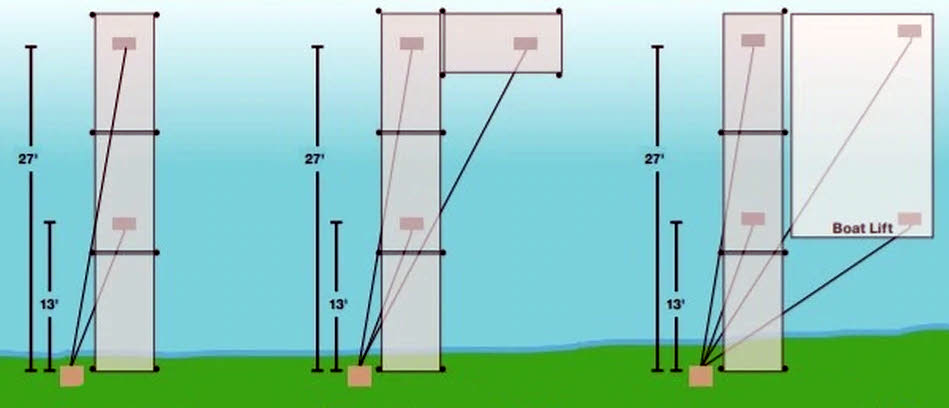
Dock
Bubbler & De-Icer Product & Website Reviews
We've
seen all manner of websites and products and here are some reviews
of popular products and websites from companies you have likely
heard of. All website reviews are based on our reviewers experience
with the websites being reviewed that offer Bubblers or deicers
and their overall knowledge of deicer systems and should be considered
as opinions and not scientific or even valid. May the buyer beware
in all cases and ask questions before you buy.
Kasco Marine, Inc. De-Icers
Kasco has been a leader in submersible deicers for years and this
website was popular amongst our testers. Good source of information
on deicing docks and all specifications for the products. They have
dealers throughout North America and our review panel found it easy
to contact them to find a reliable dealer in any area in Canada
or the United States. No pricing, typical of a manufacturers website,
but overall it instilled confidence in our test subjects.
Kasco Deicers are available pretty much everywhere from Ebay to
just about every mom-and-pop website on the web. A little digging
by the consumer can find some incredibly low prices on these systems.
Make sure you purchase from a reputable company so you will have
after sales service in the event of warranty issues or problems
with your deicer.
From
the website: https://www.de-icer.com/
"Kasco De-Icers have been trusted to protect property and equipment
for over 40 years. Kasco De-Icers have been proven to prevent ice
formation around docks, boats, equipment, etc. from areas with minimal
ice formation to over 300 miles north of the Arctic Circle. You
can rest assured, your Kasco Marine De-Icer will protect your property
during the harsh winter months. Kasco De-Icers are also used during
non-winter months for improved water quality and water movement.
Kasco De-Icers can eliminate stagnant water areas and keep trash
and debris from entering your marina, boat house, or dock area.
Use your Kasco De-Icer year round for improved water quality during
summer months and for preventing ice damage during the winter months."
Special pricing on Kasco deicers at Amazon
Ice
Eater
The range of websites offering the ice eater shows that it is a
popular low-cost deicer system and our review team was quite impressed
by the construction presentation of the ice eater system. The Power
House, Inc. uses only the finest materials in our patented product.
By example, the end bell is made of solid brass, our housings are
stainless, and the venturi shroud, which not only directs water
flow, but protects the unit if it's dropped is made from schedule
40 PVC. The Ice Eater is actually more efficient to operate than
Kasco. The Power House Ice Eater can clear a larger area than Kasco
hp. for hp. The units don't require a dock mount, a cost saving
feature. The material used in these products are superior to many
other vertical lift unit. They one of have the best warranty return
histories in the industry with some units still in operation after
20 years of use (i.e.. Cutter Marine in Maryland). They have established
over the last 28 years a strong dealer-distributor network throughout
North America. Powerhouse 3/4HP Ice Eater
From the website: https://www.thepowerhouseinc.com/ice_eater.html
"Ice Eater's Powerhouse 3/4HP Ice Eater
propeller draws up warmer subsurface water and deflects it to the
surface creating a constant circulation of warmer water that prevents
ice formation. Ice Eater will melt existing ice. Unlike other de-icing
units, Ice Eater requires no additional hardware in order to obtain
the desired deicing pattern. Ice Eater is shipped complete with
suspension lines. It can be taken out of the box, hung in place
and plugged in. Ice Eater may be hung from a pier or boat. Two to
three feet is the average operating depth. For optimal use and placement
contact your Local Ice Eater Distributor by clicking the link above.
DESIGN FEATURES: The design of the Ice Eater's venturi shroud (housing)
with outwardly flared ends draws warmer water from greater depths
than other conventional de-icers. The shroud is submersible below
the surface either vertically or angled from vertical. A set of
mounting holes at opposed positions on the flange allows the lines
to be attached."
Dock Bubbler
It appears that the dockbubbler.com
website is offline and they are no longer in business.
https://www.dockbubbler.com
This product and marketing seem to have struck a negative
chord with our reviewers. Widespread marketing of what appears to
be a substandard product left our reviewers unsure if this was a
trustworthy operation. Systems indicated on website seemed to be
cheap in quality yet pricing was high. Comments that this website
seemed to be one of many offering the exact same product lead our
reviewers to ask if it wasn't just an example of flooding the market
with the same product under different website names.
From the website: https://www.dockbubbler.com/
"DB150-85 Dock Bubbler™ System w/ 180' Bubbler Loop Our DB150
Dock Bubbler™ System features a quiet SILENT AIR™ Linear air pump
with a weather resistant aluminum housing for better ventilation
and easy maintenance. The system is very energy efficient and uses
less than 118 watts. The Dock Bubbler™ System includes 180' of weighted
bubbler line, anchor strap to secure pump to dock or flat surface,
20' supply line (runs from pump to bubbler loop), check valve, and
all required clamps and fittings. Price $1,395.00. DB150-90 DB150-90
Dock Bubbler™ System w/ 190' Bubbler Loop Our DB150 Dock Bubbler™
System features a quiet SILENT AIR™ Linear air pump with a weather
resistant aluminum housing for better ventilation and easy maintenance.
The system is very energy efficient and uses less than 118 watts.
The Dock Bubbler™ System includes 190' of weighted bubbler line,
anchor strap to secure pump to dock or flat surface, 20' supply
line (runs from pump to bubbler loop), check valve, and all required
clamps and fittings. Price $1,425.00."
It appears the dockbubbler.com website
is offline and they are no longer in business.
Pond
Books & Guides
Our
Selections On Amazon

As an Amazon
affiliate we may recieve payment for purchases made through
Amazon.
|
Dock
De-Icer
https://www.lmimg.com
The website and product did not inspire confidence in our review
panel. Pricing seemed high given the fact that the compressors seemed
like cheap linear models and the tubing seemed like low quality
clear food-grade plastic. Broken links in website and poor design
left our review team asking if it was even a legitimate business.
From
the website:
"DB40 Dock Bubbler™ System w/ 50' Bubbler Loop Our DB40 Dock
Bubbler™ System features a quiet SILENT AIR™ Linear air pump with
a weather resistant aluminum housing for better ventilation and
easy maintenance. The system is very energy efficient and uses less
than 36 watts. The Dock Bubbler™ System includes 50' of weighted
bubbler line, anchor strap to secure pump to dock or nearby flat
surface, 10' supply line (runs from pump to bubbler loop), check
valve, and all required clamps and fittings Price $575.00 - QTY
weight: 35 lbs Premium Dock Bubbler™ Enclosure The Premium Dock
Bubbler™ Enclosure, available with all Dock Bubbler™ models, houses
that best of what we have to offer in an extremely durable, lockable
fiberglass container. Features • Reinforced fiberglass construction
• Aluminum piano hinge • Stainless steel cable stays • Stainless
steel locking hasp • 4” vents • GFCI cord set • Digital thermostatic
controls • Watertight hardware • It’s ideal for those who insist
on keeping a tidy dock area – even during winter. For areas with
tidal issues, where water levels vary widely or in areas with “Brackish”
water, we recommend leaving the system running continuously to avoid
deposits from collecting on the bubbler hose and impeding its efficiency.
Because this particular item contains thermostatic controls, this
upgrade is not recommended for use in salt water. For Salt Water
applications; please refer to product number: DB-PESW"
Ice
Away
Sale Prices on Dock Deicers & Ice Eaters
https://www.arbrux.com
 The
ice-away product is along the same lines as the ice eater and the
Kasco systems. Another variation which left our reviewers looking
at a few Canadian websites that did seem to specialize in Canadian
deicing companies. The product itself left some of our test subjects
a bit unimpressed but the price points were good and the websites
offering the product seemed to be specialists in dock care so they
did receive a good rating. The
ice-away product is along the same lines as the ice eater and the
Kasco systems. Another variation which left our reviewers looking
at a few Canadian websites that did seem to specialize in Canadian
deicing companies. The product itself left some of our test subjects
a bit unimpressed but the price points were good and the websites
offering the product seemed to be specialists in dock care so they
did receive a good rating.
Arbrux Deicers from Arbrux Limited are a manufacturer of De-Icers
in Canada. The Arbrux de-Icers are more expensive than Kasco units
but they are still known for its reliability and efficiency. The De-Icer
brings the warmer, deeper water from the bottom of a body of water
to the surface to create open water by utilizing a propeller to move
the water at a rate of 500 gallons per minute.
The ˝ HP De-Icer will generally keep a 40’ diameter circle open when
the unit is placed 5’ below the surface of the water. Positioning
of the De-Icer depends on the area/structure being protected. A De-Icer
installed in a sling mount formation is ideal for boats and boat houses.
When slung between two mooring points, the De-Icer has less potential
to oscillate. For areas with one mounting point, the De-Icer should
be hung by a single chain. A float mount is also available for Deicers
that are being used in areas without a mounting point available. For
Installation after freeze up, the De-Icer can be installed through
a hole that has been augured in the ice. This is convenient for mid
winter installations.
The De-Icer comes standard with hooks and ropes for hanging. The use
of a Franklin, stainless steel, water cooled and water lubricated
motor eliminates the concern for oil leakage into the water while
allowing for a maintenance free product. Their specially designed
propeller and drive structure (both made from reinforced Zytel) create
a high water flow while protecting the propeller and power cord from
damage. Arbrux Deicers are fully ETL approved. They meet UL and CSA
standards for safety. Arbrux Limited’s Deicers come standard with
1/2hp, 120V Stainless Steel Submersible Motors and either 7.5m (25’)
or 15m (50’) power cables. Other voltages, Hp and cable lengths are
available.
From the website:
 "ICE-AWAY's high speed motor-driven propeller brings the warmer deep water
to the surface. It is diffused upward and outward into a circular
area equivalent to approximately 8 feet in diameter - for every foot
of propeller depth! A 1/2 HP ICE-AWAY with a 25' cord placed at 5
feet of depth will- in most cases keep a 40 foot circle of water ice-free
during the winter months. There are optional cord lengths and HP models.
The price of a 1/2 HP ICE-AWAY unit with a 25' power cord is $689.95
plus GST and PST. To ensure proper operation, these units should be
monitored during the winter months. Changing water levels in the lakes
could expose the de-icer unit and result in a burned out motor. De-Icer
units need to be kept at proper depth for maximum performance. Power
outages that drop breakers will need to be turned back on, to restart
the de-icer. Nothing should be left unattended for a long period of
time. " "ICE-AWAY's high speed motor-driven propeller brings the warmer deep water
to the surface. It is diffused upward and outward into a circular
area equivalent to approximately 8 feet in diameter - for every foot
of propeller depth! A 1/2 HP ICE-AWAY with a 25' cord placed at 5
feet of depth will- in most cases keep a 40 foot circle of water ice-free
during the winter months. There are optional cord lengths and HP models.
The price of a 1/2 HP ICE-AWAY unit with a 25' power cord is $689.95
plus GST and PST. To ensure proper operation, these units should be
monitored during the winter months. Changing water levels in the lakes
could expose the de-icer unit and result in a burned out motor. De-Icer
units need to be kept at proper depth for maximum performance. Power
outages that drop breakers will need to be turned back on, to restart
the de-icer. Nothing should be left unattended for a long period of
time. "
A clear and concise website offering unique systems and custom designed
dock protection systems. While no pricing was available the website
offered a good supply of information and our review teams found the
information was presented in a professional manner. Large and small
systems were presented with examples of how they would personalize
a system based on client needs. Also an authorized Canadian Kasco
Dealer.
From the website:
Using diffuser line, de-icing hose or bubbler line to Keep your dock
free from ice We recommend two different types of systems to prevent
ice from forming around a dock a "dock bubbler" type or a submersed
motor type; one uses a length or several lengths of air diffusing
diffuser line, de-icing hose or bubbler line under or around the dock
to circulate the deeper warmer water. A low cost compressor on the
dock or nearby feeds air to a length and the rising boil of active
bubbles bring warm water to the surface where it keeps ice from forming.
Even a small linear compressor, which consume very little electricity,
can produce enough air to create an active circulating movement under
your dock due to the low operating pressure of our new air diffusion
tubing.
Email
us for information or with your questions.
 Pond
Report Store Pond
Report Store
The
pond report also has information on:
Algaecides
& Bacteria | Deicers
& Bubblers | Weed
Removal | Liquid
Bacteria | Pond
Pumps & Fountains | Aeration
| Winter
Pond Care | Algae
Control | Pond
Liner | Muck Pellets | Build
a Solar Aerator | Rotary
Vane Compressors | Floating
Fountains
| Building
a Pond | Linear
Air Compressors & Pumps | Weighted
Airline | Diffusers
& Airstones | Solar
Aeration Systems | DC
& Battery Operated Pumps | Windmill
Aeration | Dock
Bubbler Packages | Building
a Waterfall |
Dyes & Colorants | Consultations
| Questions & Answers
| Links &
Resources | Eurasian
Milfoil
| |
Mosquito Control | Pondkeeper
Treatments | Aeration
Systems | Septic
Bacteria | Grease
Trap Blocks | Dissolved
Oxygen Meters | SOTR
& Pumping Rates |
Portable
Generators |
Duckweed Control
|
Pond
Plans & Pond Building Books & Guides |
© 2007
- 2024 The Pond Report
about
us | privacy
policy | contact
us |

 Pond
Report Store
Pond
Report Store


 Our
deicing experts have years of experience with design and installation
of bubblers and de-icers in mining, stormwater, gas and oilsands
and tailings ponds, ski hills, municipal docks and marinas
and dam deicing and pumphouse deicing. Using the most efficient
systems we can design or recommend the ideal deicing or bubbler
system for any job, large or small.
Our
deicing experts have years of experience with design and installation
of bubblers and de-icers in mining, stormwater, gas and oilsands
and tailings ponds, ski hills, municipal docks and marinas
and dam deicing and pumphouse deicing. Using the most efficient
systems we can design or recommend the ideal deicing or bubbler
system for any job, large or small.






